--Lesson 1: How to play mahjong?--
Let's start with some definitions of terms. A complete list of definitions of terms can be found in the section of the same name at the beginning of the "Appendix" chapter.
- Mahjong: An intellectual board game of Asian origin for four players. The goal of the game is to build a complete hand (“mahjong”) having valuable combination(s).
- Deal (hand): Everything that occurs between an initial distributing of tiles and either declaring "Hu" (winning) by three players or taking all the tiles from the wall.
- "Hu" (Chin. 和 or 胡): A word for declaring mahjong (winning).
- Hand: Tiles belonging to one of the players.
Pattern: decorated in a unified manner tile, for instance,.png) or
or .png) .
.
Note: Tile “pattern” can alternatively be defined as “unique tile face”.
--Game Objective--
Mahjong is a board game for four players. The game objective is to score more points than other players. In every deal, the player's main occupation is building a hand with valuable features. The more features, the more difficult to build the hand, the more points it is worth.
On the other hand, the opponents are not asleep and are also building their hands. When your opponent wins, you can lose points, and the more “fancy” the opponent's hand is, the more points will be lost. Thus, the player's primary goal is to score points for their own hand and, if possible, not to lose points to the hands of opponents.
--Mahjong playing set--
Mahjong is played by tiles in the shape of a parallelepiped, somewhat similar to domino tiles, but slightly thicker. Typical sizes of tiles that are played at tournaments or at home are 36x26x16 mm or 1-2 mm larger. Such proportions allow you to comfortably manipulate tiles: building a wall, lining up the tiles of the player's hand, flipping several tiles at the same time, etc. In general, you can find mahjong sets with different tile heights: from 18 to 60 mm. Depending on the rules, the playing set may have a different number of tiles: 108, 112, 120, 136, 144, 152, etc. As a rule, the main part of the set is tiles of three suits, "Bamboo", "Dots", "Characters", honour tiles "Winds" and "Dragons", and there are four copies of each pattern. In addition, the set may contain other tiles, “Flowers” and “Seasons”, as well as various accessories: cubes, counting sticks, wind indicators, etc.--Lesson 2: Starting the Deal--
- Wall: Mahjong tiles, built in the form of a square. Also, the part of the wall that is directly in front of the player in their play area is called the "wall" of the corresponding player.
-
Wall Break: An imaginary plane between adjacent stacks (of two tiles high) of the
wall.
All the tiles in the deal are taken from the wall break in a clockwise direction.
Note: Wall break is denoted in practice mechanically by separating two adjacent stacks of tiles from each other. - Forbidden Suit: The suit that must be absent in the player's hand when declaring mahjong.
- Indent: The number of stacks of tiles of the player's wall before the break.
- "Standing" Tiles: The player's tiles outside of melded sets.
The process of playing any deal can be divided into the following stages:
- Preparing the wall: mixing of the tiles, building and breaking the wall, distributing the tiles.
- The choice by the players of a prohibited suit.
- The initial East’s turn.
- The choice by the players of a prohibited suit.
- Deal finishing: three “Hu” declared or tiles in the wall ended.
- Scoring.
--Playing Space--
For a comfortable play, a square table is required with dimensions corresponding to the size of the tiles. The whole playing space is divided into several zones, each zone consists of four parts corresponding to each of four players (see figure below).
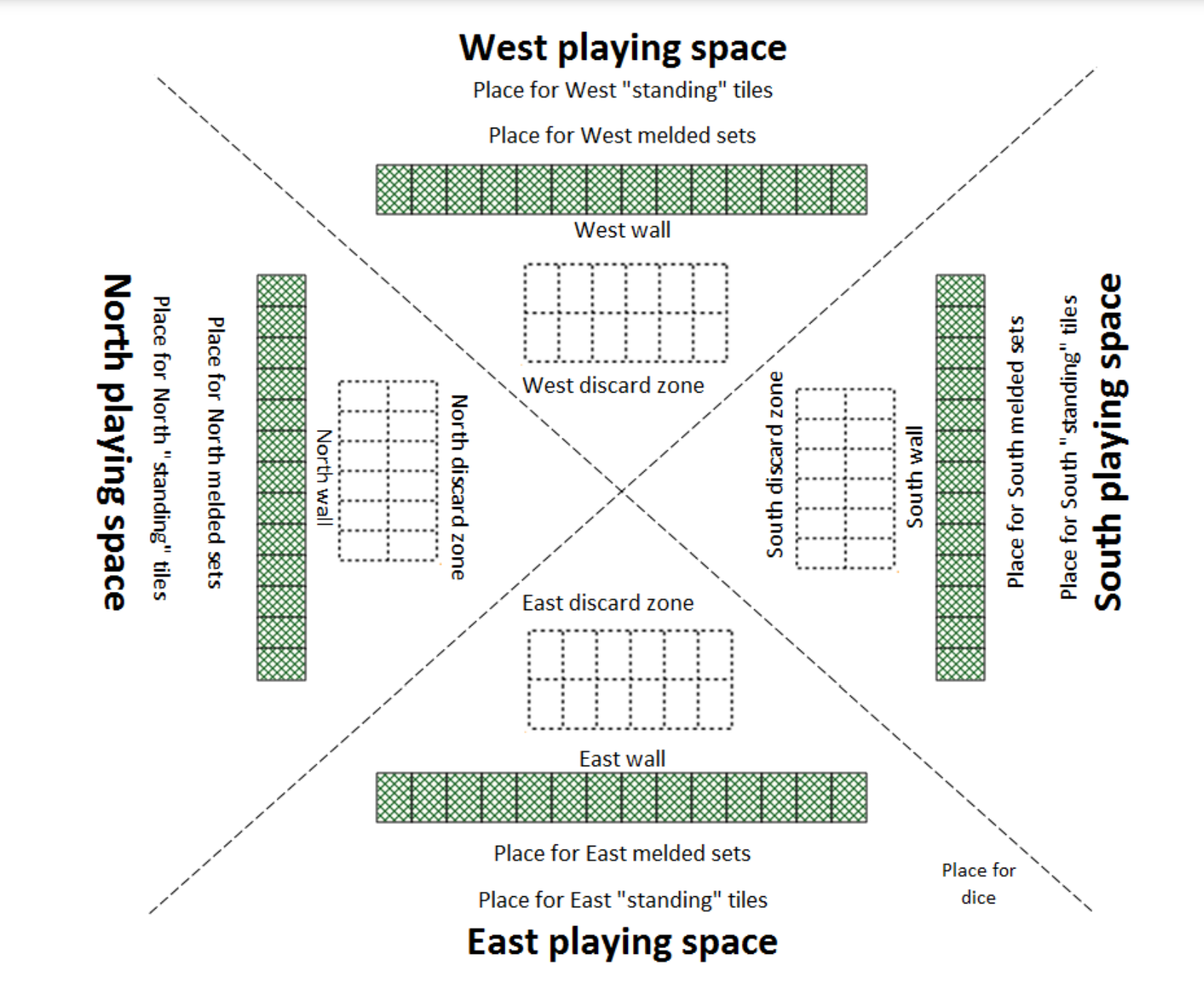
Each player (referred to as Winds: East, South, West, and North) conventionally uses a triangular space bounded by large diagonals and the edge of the table on the player's side. Tiles placed in a square with thirteen or fourteen tiles on each side and two tiles high are called a "wall."
The area inside the square bounded by the wall is called the "discard zone", where the player discards the played tiles face up in rows of six tiles from left to right (in the figure, places for the discarded tiles are conventionally indicated by a dotted line).
During the game, the tiles outside melded sets ("standing" tiles) are placed directly in front of the player and in front of the wall line. The melded sets are laid by the player in front of them, between the "standing" tiles and the player's wall.
East (the dealer): East, the player who starts the deal, places two six-sided dice on the right immediately after two throws and before dealing the tiles.
It should be noted that the arrangement of Winds at the table does not match the compass; two opposite sides are reversed. Everything falls into place if you raise your eyes and look at the sky. Winds in mahjong are located on the sides of the heavenly compass, not the earthly compass!
--Building a Wall and Distributing Tiles--
Before the deal starts, the tiles are turned face down and shuffled thoroughly, and then lined up in a square two tiles high and fourteen tiles wide for East and West and thirteen tiles wide for South and North.
Note: The wall should be built at a sufficient distance from the edge of the table to allow room for the player's "standing" tiles and sets.
To determine the starting point from which tiles will be distributed from the wall, the dealer (East) rolls two dice in the center of the table. The resulting value of the sum of points indicates the player whose wall will be dismantled first. This value is counted counterclockwise (if looked from the center of the table), starting from East and counting players: "1" means East, "2" means South, "3" means West, and "4" means North.
Thus, it appears that the resulting values of the dice rolls indicate the following:
- 5 or 9: East (second player to throw dice).
- 2, 6, or 10: South.
- 3, 7, or 11: West.
- 4, 8, or 12: North.
The minimum value of points at two dice ("indent") is counted clockwise (if looked from the center of the table) from the right end of the wall to be dismantled, defining the tiles stack, after which the wall break should be made.
Examples
- Example 1: East rolls 6+4=10, which means the player is South, indent equals 4.
- Example 2: East rolls 2+2=4, which means the player is North, indent equals 2.
- Example 3: East rolls 5+4=9, which means the player is East, indent equals 4.

After determining the wall break, tile distribution starts: ultimately, East should have 14 tiles, while all other players should have 13 tiles. Players starting from East and going counterclockwise (E → S → W → N) receive four tiles three times (two stacks each), with tiles taken from the wall in a clockwise direction.
East takes the thirteenth and fourteenth tiles from the top of the first and third stacks, counting clockwise from the current wall break. After this:
- South takes the bottom tile of the outermost stack.
- West takes the top tile of the new outermost stack.
- North takes the bottom tile of the outermost stack.
In the figure "Tiles Distribution After Breaking a Wall" (see above), the tiles distributed among the players after the wall break are schematically shown with color-coding.
Example Dice Roll: "6+4"
For a dice roll 6+4, the South wall will be dismantled, and the indent value is 4. After counting four stacks from the right end, the South wall breaks. Here is how tiles are distributed:
- East takes the first two stacks after the break, then South takes two stacks, followed by West and North. All players now have four tiles.
- East takes two stacks from different walls (South wall ends, East wall begins), then South, West, and North take two stacks. All players now have eight tiles.
- East, South, and West take two stacks from the East wall, while North takes stacks from different walls (East wall ends, North wall begins). All players now have twelve tiles.
- East takes the top tiles from different stacks, South takes the bottom tile from the outermost stack, West takes the top tile from the new outermost stack, and North takes the bottom tile from the outermost stack.
The attentive reader will calculate that there are 1+2*9+2*14+2*4 = 55 tiles left in the wall, and there are 14 + 13*3 = 53 tiles in total in the players' hands.
Final State After Tiles Distribution
The figure "After Tiles Distribution" (see below) shows the state of the wall and the players' tiles after tile distribution for a dice roll 6+4. Note that East received fourteen "standing" tiles, while all other players received thirteen. After parsing the wall, from the side of the main end of the wall, there is a stack of only one tile.
--Forbidden Suit--
After distributing the tiles from the wall and before the first move, each player must assign a so-called "forbidden" suit. To indicate it, each player separates a tile of the forbidden suit from their hand and places it face down in the center in front of them. The same tile is the first mandatory discard of the player.
Why face down? Because it is impossible to give opponents valuable information ahead of time about which suit in the hand will be forbidden. All players must make this decision independently of each other, and it will no longer be possible to change it until the end of the deal. If the player does not have tiles of a forbidden suit in their hand, then a special card-indicator is used instead of a tile.
Not only must the hand with the declared “Hu”, but also the hand after taking all the tiles from the wall, not contain tiles of the player's forbidden suit. Otherwise, the player will be penalized with 48 points.
Penalty and Exceptions
Note: A 48-point penalty is incomparable with the size of the potential win and should be avoided by all means, discarding tiles of the forbidden suit at the very beginning. There are two possible exceptions to this rule:
- Firstly, if all the player's discards are only tiles of the forbidden suit, then after taking all the tiles from the wall, the penalty is not charged.
- Secondly, a player can discard tiles of a different suit even while having tiles of a forbidden suit in the hand, taking the risk of being penalized.
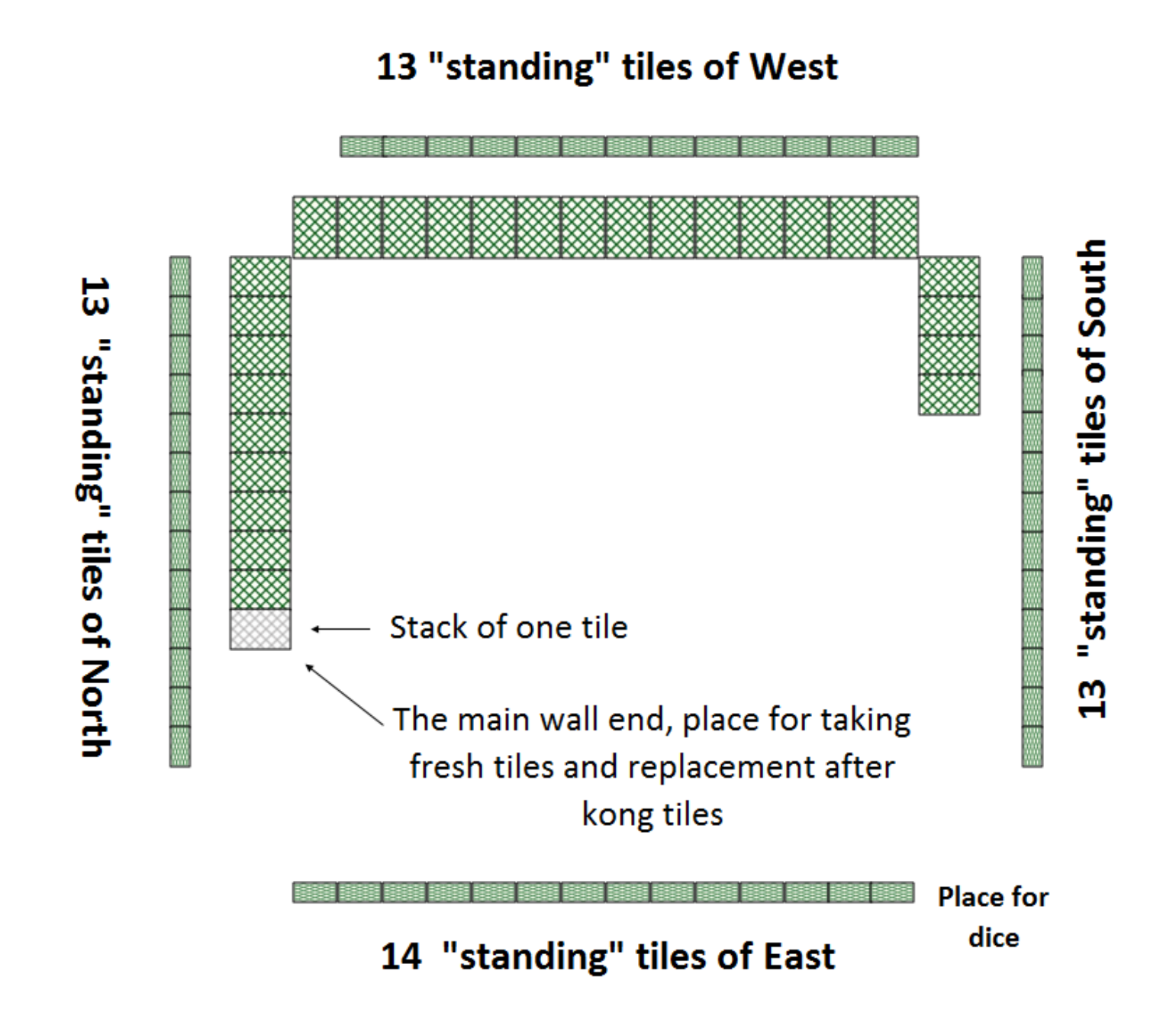
--Lesson 3: Hand and Its Components--
- Set: The structural element of the hand.
-
Chow: A set consisting of tiles of the same suit with three consecutive numbers,
for instance,
.png)
.png)
.png) .
.
-
Pung: A set consisting of three identical tiles, for instance,
.png)
.png)
.png) .
“Pung” is also the word for declaring Pung.
.
“Pung” is also the word for declaring Pung.
-
Pair: Two identical tiles, for instance,
.png)
.png) .
.
-
Kong: A special set consisting of four identical tiles, for instance,
.png)
.png)
.png)
.png) . “Kong” is
also the word for declaring Kong.
. “Kong” is
also the word for declaring Kong.
- Melded Set: A set which contains a tile claimed from a discard.
- Concealed Set: A set, all tiles of which were taken from the wall.
- Move: A set of actions during the player’s turn.
- Declaration: A player's word with the intention to declare mahjong or a set.
--Lesson 4: Game Mechanics--
Playing the Deal
The process of playing any deal consists of three phases: preparatory, gameplay, and scoring.
Preparatory Phase
In the preparatory phase, the following steps are completed:
- Tiles are shuffled.
- Players build a wall.
- East rolls two dice.
- According to the dice values, the wall and the place for the break are determined. Tiles are then distributed to the players: East gets fourteen tiles, while the rest of the players get thirteen.
- Each player must choose a forbidden suit, which is a suit whose tiles should not appear in the player's completed hand or in the player's hand after taking all the tiles from the wall.
- After all players have placed a tile (or card-indicator) of their forbidden suit, East should move.
--The Initial East’s Turn--
On his / her initial turn, East has only three options:
-
Declare “Hu”: East may already have a completed hand and an intention to declare
“Hu”.
In this case:
- After the declaration of "Hu," all tiles of East's hand are turned face down.
- The indicator card (used to indicate the forbidden suit) is turned face up.
- It is important to note that to declare “Hu,” East must strictly not have tiles of the forbidden suit in his / her starting hand, meaning that an indicator card has been used.
- A card indicating the declaration of "Hu #1" (if such cards exist in the game set) is laid out next to East's hand.
- Declare a Concealed Kong: East can declare a concealed kong and keep the turn. After laying out four tiles and taking a replacement tile, East is in exactly the same triple choice situation (declaring “Hu,” declaring a concealed kong, or discarding a tile), with the only difference that there are eleven "standing tiles" in hand instead of fourteen.
- Discard a Tile: East can discard a tile to pass the turn to the next player (South).
--Moves--
The deal is a sequence of players' moves done in turn, and it ends with one of two finals: either three players declare “Hu”, or the wall ends. A player's turn begins by either picking a fresh new tile from the wall or taking a discarded tile after a claim. The player's turn ends either with the “Hu” declaration or the obligatory discarding of a tile.
Passing the Turn
The turn is passed between players in two different ways:
- If there is no claim on the discarded tile, the turn proceeds counterclockwise in the direction “East → South → West → North → East...”, skipping all “Hu” players (they temporarily leave the deal until the end). The next player's turn begins by picking a fresh new tile from the wall.
- If there is one claim on the discarded tile, the tile is transferred to the player who made the declaration, so that this player’s turn starts by taking the discarded tile instead of picking a fresh tile from the wall.
-
When there are multiple claims, the discarded tile is transferred according to the
declaration priority rule:
- “Hu” declaration: Supersedes the declaration of “Pung” / “Kong.”
- Multiple “Hu” declarations: Each Hu-player receives a “copy” of the winning tile.
Important Note: First Discard Procedure
The first discard procedure can present an inconvenience, even for experienced players. The mandatory overturning of the first tile in the center of the table may feel unusual. Practical advice:
- Use one hand to grab the first tile off the wall and the other hand to flip the tile in the center of the table.
- This approach helps avoid situations with two demolished tiles or other deviations in the game.
--Discard Claim--
The player is given 3 seconds to claim the discarded tile (that is, to make a declaration). At the end of this period, the right to use the discarded tile is voided, and the move is passed to the next player counterclockwise, skipping all the players who declared “Hu”.
Multiple “Hu” Declarations
With multiple “Hu” declarations on the discarded tile, all such declarations are satisfied, and it is considered that the discarded tile belongs to all players who declared “Hu”. When the hand is scored at the end of the deal, the “shared” winning tile is used by the players one by one.
Skipping a Discard
If a player skips a discard that could be claimed for “Hu”, then this player is not allowed to declare “Hu” until taking a tile from the wall, except in the situation where the winning hand has a greater value.
Turn Passing After “Hu”
If “Hu” was declared by two players on the discarded tile, then the next move is made by the player who is sitting in the circle after the second player who declared “Hu”, counting counterclockwise from the discarder.
--When the Wall Ends--
When there are no tiles left in the wall, the following rules apply for declarations:
- The player who took the last tile from the wall can only declare “Hu”.
- If the player does not declare “Hu”, they are obliged to discard a tile.
- On that discard, only “Hu” and “Pung” declarations are allowed.
- If a “Pung” is declared, the new tile must be discarded, becoming the new last discard. This tile can again be taken to declare another “Pung”, and so forth.
--Declaring “Hu”--
The player who declares “Hu” stops playing until the end of the deal and turns their "standing" tiles face down. Depending on how “Hu” is declared, the following actions are taken:
-
“Hu” on Discard: The winning tile is placed face up and rotated 90 degrees to
indicate
the player from whom the “Hu” was declared. For example:
- Winning tile placed as:
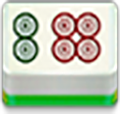



 ,
,




 , or
, or




 .
.
- Winning tile placed as:
-
Self-Drawn “Hu”: The winning tile is placed aside face down. For example:
- Winning tile placed as:




 .
.
- Winning tile placed as:
After the “Hu” declaration, if there are two or three players in the deal without "Hu", the deal continues ("battle to the end").
--Starting New Deal--
When the Deal Ends
The deal ends under the following conditions:
- Three players declared “Hu”.
- Tiles in the wall are over, and the active player has ended their turn.
- The time allotted for the session in the tournament has expired.
Dealership Transfer
The dealership is transferred based on the following rules:
- If nobody declares “Hu”, the dealer remains the same.
- If the first “Hu” was declared by a single player, this player becomes the next dealer.
- If the first “Hu” was declared by multiple players on the same discard, the discarder becomes the next dealer.
Maximum Number of Deals
A new deal does not start if the maximum number of deals in the tournament session has already been played.
--Lesson 5: General Rules--
Key Definitions
- Wait: The state of the player's hand when one tile is missing before the completed hand. The term "wait" also refers to all tiles that complete the hand.
- Fan: Doubling the hand points.
- Value Combination: What gives fans (doubles) on the hand.
How the Deal Can Finish
The deal can finish in only two ways:
- Three players declare “Hu”.
- The wall ends while there are more than one non-Hu players.
Gaining and Losing Points
Players can gain points from:
- Kongs.
- “Hu” declaration.
- “Ready” hand.
Players can lose points from:
- Other players’ kongs.
- “Hu” declaration.
- Other players’ “ready” hand.
- Forbidden suit penalty.
After a player declares “Hu”, they are temporarily out of the deal and no longer participate in gaining or losing points until the deal is finished.
Final Scenarios
“3-Hu” Final
- Only the hands of Hu-players are shown and checked, and points are awarded for kongs (if any) and “Hu”.
- The non-Hu player's hand is not shown or checked, but points are awarded for kongs (if any).
“Wall Ends” Final
- The hands are shown and checked.
- Hu-players are awarded points for kongs (if any) and “Hu”.
- Non-Hu “ready” players are awarded points for kongs (if any) and waiting hands.
- Non-Hu “non-ready” players only lose points on each occasion; points for kong are not awarded.
--Value Combinations and Fans (Doubles)--
In Sichuan Mahjong, a scoring system based on doubles (fans) is used. The table below lists all the value combinations used for scoring a hand with “Hu” or a waiting hand:
For each valuable combination, 1 or 2 fans are added, and the total number of fans is summed up. The hand value is doubled from the starting value of 1 point as many times as the total fans calculated, up to a certain limit.
The typical limit is:
- 3 fans: Maximal hand value is 2 × 2 × 2 = 8 points (as in MIL’s version of rules).
- 4 fans: Maximal hand value is 2 × 2 × 2 × 2 = 16 points (as played in Russia and on the MahjongSoft site).
Scoring Table
| No. | Combination | Fan (Doubles) | Description |
|---|---|---|---|
| 1 | Kong | 1 | For each 4 identical tiles in kong. |
| 2 | Root | 1 | For each 4 identical tiles in two or more sets. |
| 3 | All Pungs | 1 | Hand with four pungs or kongs and a pair. |
| 4 | Golden Wait | 1 | Four melds (pungs or kongs) in hand, the winning tile completes the pair. Add 1 fan for "All Pungs." |
| 5 | Full Flush | 2 | All tiles in the hand are one suit only. |
| 6 | Seven Pairs | 2 | Seven pairs in hand. |
| 7 | Win after Kong | 1 | Declaring Hu on a replacement tile after making a kong. |
| 8 | Shoot after Kong | 1 | Declaring Hu on a tile discarded after making a kong. |
| 9 | Robbing the Kong | 1 | Declaring Hu by robbing a kong. |
| 10 | Under the Sea | 1 | Declaring Hu on the last tile in the wall or on the discard after the last tile. |
For each valuable combination, 1 or 2 fans are added, and the total number of fans is summed up. The hand value is then doubled from the starting value of 1 point as many times as the total fans calculated, up to a certain limit.
The typical value of that limit is:
- 3 fans: The maximal hand value is calculated as 2 × 2 × 2 = 8 points (as in MIL’s version of rules).
- 4 fans: The maximal hand value is calculated as 2 × 2 × 2 × 2 = 16 points (as played in Russia and on the MahjongSoft site).
Thus, the doubling process is determined by the total fans and the specific limit set for the game.
--Payments--
To calculate the hand value when a player declares Hu, the fans are summed up for all valuable combinations applicable to this hand.
For a waiting hand, the maximum value of a possible hand is calculated based on the variety of the winning tiles.
| Hu Payment Event | Points | Who is Paying | Who is Getting the Payment |
|---|---|---|---|
| Hu is declared on a discard | Hand Value | The discarder | Each player declaring Hu on this discard |
| Hu is declared on a self-drawn tile | Hand Value + 1 | Each non-Hu player | The player declaring Hu on this self-drawn tile |
| The wall ends with two or more non-Hu players | Hand Value of the best hand the ready player is ready for | Each non-Hu “non-ready” player | Each non-Hu ready player |
Payments in the “Wall Ends” Final
-
Each non-Hu player can have only three states:
- Ready: The player is prepared to declare Hu with the right tile.
- Non-Ready: The player cannot declare Hu.
- Having Forbidden Suit: A hand with tiles of the forbidden suit, which is considered “non-ready”.
- A hand with the forbidden suit gets a penalty of 48 points, and other players do not receive points for this penalty.
- Each non-Hu “non-ready” player pays each non-Hu “ready” player the theoretical maximum value of the hand.
Theoretical Maximum Value
The theoretical maximum value of the hand is calculated based on the best possible hand the “ready” player could achieve with the available tiles.
--Kongs--
Kongs are an important source of points. The number of points declared by the player's kongs may even exceed the points for the declared “Hu”.
Scoring and Payments for Kongs
The scoring and payment rules for Kongs are as follows:
- The player declaring a Concealed Kong receives 2 points from each non-Hu player.
- The player declaring a Melded Kong receives 2 points from the discarder.
- the player declaring Promoted Kong receives 1 point from each non-Hu player (but only in case of a freshly taken from the wall tile, otherwise, in case of a tile added to Melded Pung from the hand such a kong is named Postponed Kong and does not bring points at all)
- No kong payment if the Promoted Kong was robbed.
- No kong payment if another player declares Hu on the tile discarded after the kong is made.
- No kong payment if the player who declared the kong is a non-Hu “non-ready” player when the wall ends.
Kong Payment
The following table outlines the payment rules for different Kong events, including points, who is paying, and who is receiving the payment:
| Kong Payment Event | Points | Who is Paying | Who is Getting the Payment |
|---|---|---|---|
| Concealed Kong is declared | 2 | Each non-Hu player | The player declaring the kong |
| Melded Kong is declared on a discard | 2 | The discarder | The player declaring the kong |
| Promoted Kong on a freshly taken from the wall tile | 1 | Each non-Hu player | The player declaring the kong |
| Postponed Kong on a tile from the hand | 0 | Nobody | Nobody |
-
--Waits--
Here are examples of waits, that is, tiles that complete the hand. The table only shows hand fragments with winning tiles.
Examples of waits
| Hand | Waiting tiles | Tile patterns |
|---|---|---|
.png) |
.png) |
1 |
.png) .png) |
.png) |
1 |
.png) .png) |
.png) |
1 |
.png) .png) |
.png) and and .png)
|
2 |
.png) .png) .png) .png) |
.png) and and .png)
|
2 |
.png) .png) .png) .png) |
.png) and and .png)
|
2 |
.png) .png) .png) .png) |
.png) , , .png) and
and .png) |
3 |
.png) .png) .png) .png) .png) |
.png) , , .png) and
and .png) |
3 |
.png) .png) .png) .png) .png) .png) .png) |
.png) , , .png) and
and .png) |
3 |
.png) .png) .png) .png) .png) .png) .png) |
.png) , , .png) , ,
.png) , , .png) and and .png)
|
5 |
.png) .png) .png) .png) |
.png) and and .png)
|
2 |
.png) .png) .png) .png) .png) .png) .png) |
.png) , , .png) and
and .png) |
3 |
It is extremely important to understand when finding waiting tiles that the entire hand is
being used for that. The separation of the completed hand by sets occurs after the winning
tile is obtained, not before that. For instance, a tile .png) in the
hand
in the
hand .png)
.png)
.png)
.png)
.png)
.png)
.png) ;
;
Examples of How Tiles Enter Sets
-
A tile in the hand:
- Enters chow
.png)
.png)
.png) when waiting for
when waiting for .png) (
( .png)
.png) +
+ .png)
.png)
.png) +
+ .png)
.png)
.png) ).
).
- Enters a pair when waiting for
.png) (
( .png)
.png)
.png) +
+ .png)
.png) +
+ .png)
.png)
.png) ).
).
- Enters chow
.png)
.png)
.png) when waiting for
when waiting for
.png) (
( .png)
.png)
.png) +
+ .png)
.png)
.png) +
+ .png)
.png) ).
).
- Enters chow
There is one major exception to the definition of wait: a player cannot wait on a tile if all four copies of that tile are in the "standing" tiles of the player's hand. This is called an “exhaustive” wait.
Example 1: Three sets are declared, there are .png)
.png)
.png)
.png) in hand. Is the hand
waiting or not? No! The hand seems to be waiting on
in hand. Is the hand
waiting or not? No! The hand seems to be waiting on .png) , but since
all four copies of this
tiles are in the hand, there is no wait.
, but since
all four copies of this
tiles are in the hand, there is no wait.
Example 2: One set is declared, there are .png)
.png)
.png)
.png)
.png)
.png)
.png)
.png)
.png)
.png) in
hand. The hand seems to be waiting on
in
hand. The hand seems to be waiting on .png) and
and .png) , however, since all four copies of
each of these tiles are in the hand, there is no wait.
, however, since all four copies of
each of these tiles are in the hand, there is no wait.
--False “Hu”--
All declared “Hu” are considered valid until the scoring is complete. However, if at the end of the deal during the check it is determined that a player has declared a false “Hu” (for example, the hand does not have a structure allowed by the Rules or contains a forbidden suit), the following consequences apply:
- The player loses all points for the declared kongs.
- The player must also pay a penalty.
Impact on Determining the Dealer
The declaration of a false “Hu” is not taken into account when determining the new dealer. It is treated as if no “Hu” was declared. For example:
- If two players declared the first mahjongs, but one of them turned out to be a false “Hu”, the player with the correct mahjong becomes the dealer in the new deal.
--Penalties--
Penalties regulate the violations and deviations in the game. The following rules describe the consequences for various infractions:
1. Penalty for False “Hu”
- A player who has declared a false “Hu” (i.e., the hand does not have a structure allowed by the Rules or contains a forbidden suit) must pay 8 points to each player who was still in the game at the time of the declaration.
- All kong payments declared by the offending player must be returned.
-
Examples:
- If a false “Hu” was declared first in the deal, and three players remained in the game, the total penalty is 24 points (8 points paid to each of the three players).
- If two players simultaneously declared false “Hu” on a discard after the first “Hu” in the deal, and only one player remained in the game, each offending player pays 8 points to the last player.
- Note: This severe penalty compensates other players for the lost opportunity to score points for declared kongs and “Hu” from the gameplay left by the offending player.
2. Penalty for Declaring Forbidden Suit
- A player who declares a set of forbidden suit tiles receives a penalty of 48 points, even in the 3-Hu final.
-
If a forbidden suit is present in a hand with a declared “Hu”, the player incurs:
- A penalty of 48 points for the forbidden suit.
- A penalty for a false “Hu” (8 points per remaining player).
- In the case of a “wall ends” final, the hand with a forbidden suit is considered as a hand without wait and incurs the same penalties.
--Lesson 6: Scoring Examples--
In this lesson, we will demonstrate various examples of completed hands.
--The Simplest Valuable Combinations--
Below are examples of completed hands containing the indicated valuable combinations (let's assume that the forbidden suit is "Characters"):
-
A simple hand without a valuable combination, 0 fans:
.png)
.png)
.png) ,
, .png)
.png)
.png) ,
, .png)
.png)
.png) ,
, .png)
.png)
.png) ,
, .png)
.png)
-
"Kong", 1 fan:
.png)
.png)
.png) ,
, .png)
.png)
.png)
.png) ,
, .png)
.png)
.png) ,
, .png)
.png)
.png) ,
, .png)
.png)
-
"Root", 1 fan:
.png)
.png)
.png) ,
, .png)
.png) ,
, .png)
.png)
.png) ,
, .png)
.png)
.png) ,
, .png)
.png)
.png)
-
"All Pungs", 1 fan:
.png)

.png) ,
, .png)
.png)
.png) ,
, .png)
.png)
.png) ,
, .png)
.png) ,
, .png)
.png)
.png)
-
"Golden Wait" + "All Pungs", 2 fans:
.png)

.png) ,
, 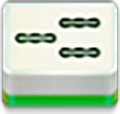
.png)
.png) ,
, .png)
.png)
.png) ,
, .png)
.png) ,
, .png)
.png)
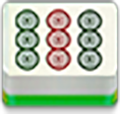
-
"Full Flush", 2 fans:
.png)

.png) ,
, 
.png)
.png) ,
, .png)
.png)
.png) ,
, .png)
.png)
.png) ,
, .png)
.png)
-
"Seven Pairs", 2 fans:
.png)
.png) ,
, .png)
.png) ,
, .png)
.png) ,
,.png)
.png) ,
, .png)
.png) ,
, .png)
.png) ,
, .png)
.png)
--Special Conditions for Winning Tile--
The examples below show four valuable combinations associated with the special conditions for obtaining winning tiles:
-
"Win after Kong", 1 fan:
After declaring a kong on B8, replacement tile D7 completes the hand.
.png)
.png)
.png) ,
,

.png)
.png)
 ,
,
.png)
.png) ,
,
.png)
.png)
.png) ,
,
.png)
.png) +
+ .png)
-
"Robbing the Kong", 1 fan:
After the declaration of a promoted kong on D8 by another player, this tile completes the hand.
.png)
.png)
.png) ,
,
.png)
.png) ,
,

.png)
.png) ,
,
.png)
.png)
.png) ,
,
.png)
.png) +
+ .png)
-
"Shoot after Kong", 1 fan:
After the declaration of a kong by another player, the discarded tile B5 completes the hand.
.png)
.png) ,
,

.png)
.png) ,
,
.png)
.png)
.png) ,
,
.png)
.png)
.png) ,
,
.png)
.png) +
+ .png)
-
"Under the Sea", 1 fan:
When no tiles are left in the wall, the winning tile B4 is either taken from the wall (the last tile) or discarded by another player (the last discard).
.png)
.png) ,
,

.png)
.png) ,
,
.png)
.png)
.png) ,
,
.png)
.png)
.png) ,
,
.png)
.png) +
+ .png)
Note: In the “wall ends” final, the above-stated special valuable combinations do not apply, as no special conditions for obtaining a winning tile are assumed.
--Hand Value Theoretical Maximum--
In the “wall ends” final, each waiting hand must be calculated at its maximum value. What does this mean in practice? And why can the value of the same hand differ? The maximum value of the hand is chosen from the values obtained separately for all the different waiting tiles of the hand. It is important that no special conditions for the winning tile are assumed.
Valuable Combinations That Do Not Apply
The following valuable combinations cannot increase the value of the hand in the "wall ends" final:
- If the hand is waiting for exactly one tile ("Golden Wait"), there is no choice of hand value.
- Four valuable combinations with special conditions for obtaining the winning tile ("Win after Kong", "Robbing the Kong", "Shoot after Kong", and "Under the Sea") do not apply.
- The combination "Kong" does not apply, as it requires a declaration.
- The combination "Full Flush" does not apply, as all the waiting tiles already belong to the same suit.
The analysis leaves only three valuable combinations that can be obtained with the proper selection of winning tile:
-
.png)
.png)
 ,
,
.png)
.png)
.png)
.png)
.png)
.png)
.png)
.png)
.png)
.png)
.png) — the hand is
waiting for
— the hand is
waiting for .png) and
and .png) , in
case of
, in
case of .png) a valuable combination "Root" is added
totaling 1 fan.
a valuable combination "Root" is added
totaling 1 fan.
-
.png)
.png)
 ,
,
.png)
.png)
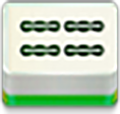
.png) ,
,

.png)
.png) ,
,
.png)
.png)
.png)
.png) — the
hand is waiting for
— the
hand is waiting for .png) ,
, .png) and
and .png) , in case of
, in case of .png) a valuable combination "All
Pungs" is added totaling 1 fan.
a valuable combination "All
Pungs" is added totaling 1 fan.
-
.png)
.png)
.png)
.png)
.png)
.png)
.png)
.png)
.png)
.png)
.png)
.png)
.png) — the hand is waiting
for
— the hand is waiting
for .png) and
and .png) for the
regular hand structure without doubles (0 fans), but also is
waiting for
for the
regular hand structure without doubles (0 fans), but also is
waiting for .png) the irregular hand structure "Seven Pairs",
valuable combinations
"Seven Pairs" and "Root" are added totaling 3 fans.
the irregular hand structure "Seven Pairs",
valuable combinations
"Seven Pairs" and "Root" are added totaling 3 fans.
--Compatibility of Valuable Combinations--
It is quite obvious that a completed hand can have several valuable combinations.
Below is a complete table of compatibility of valuable combinations in a hand with "Hu". Two valuable combinations are considered "compatible" if one can find a hand in which both valuable combinations are present. Additionally, a combination can be "auto-compatible", meaning it can be present in the hand multiple times. For instance, a "Kong" is possible in the hand four times.
Here are examples of hands with 3 fans:
-
"Kong" + "Kong" + "All Pungs":
.png)
.png)

.png) ,
,
.png)
.png)
.png)
 ,
,
.png)
.png)
.png) ,
,
.png)
.png)
.png) ,
,
.png)
.png)
-
"Kong" + "All Pungs" + "Golden Wait":
.png)
.png)
.png)
 ,
,
.png)
.png)
 ,
,

.png)
.png) ,
,
.png)
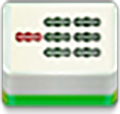
.png) ,
,
.png)
.png)
-
"Full Flush" + "Kong":
.png)
.png)

.png) ,
,
.png)
.png)
 ,
,
.png)
.png)
.png) ,
,
.png)
.png)
.png) ,
,
.png)
.png)
-
"Full Flush" + "Root":
.png)

.png) ,
,
.png)
.png)
 ,
,
.png)
.png) ,
,
.png)
.png)
.png) ,
,
.png)
.png)
.png)
-
"Full Flush" + "All Pungs":
.png)

.png) ,
,
.png)
.png)
 ,
,
.png)
.png)
.png) ,
,
.png)
.png) ,
,
.png)
.png)
.png)
-
"Seven Pairs" + "Root":
.png)
.png) ,
,
.png)
.png) ,
,
.png)
.png) ,
,
.png)
.png) ,
,
.png)
.png) ,
,
.png)
.png) ,
,
.png)
.png)